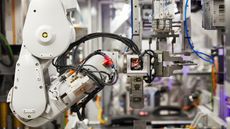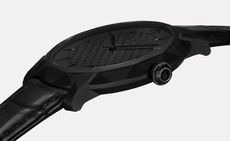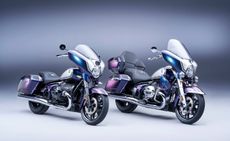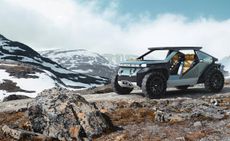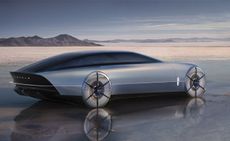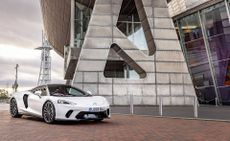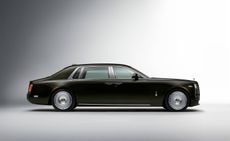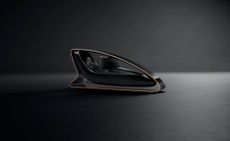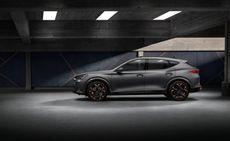Remembering Syd Mead, the ‘Oscar Wilde of designers’
The American ‘visual futurist’ behind the imaginary worlds for movies including Blade Runner and Tron as well as conceptual design for Ford, Phillips and Sony passed away aged 86 in December 2019. Here Wallpaper* salutes his life and influence
- (opens in new tab)
- (opens in new tab)
- (opens in new tab)
- Sign up to our newsletter Newsletter
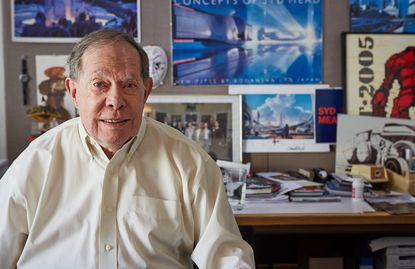
The number of times Syd Mead’s name is mentioned as an inspiration by designers of all types – but especially professional car designers from Ferrari’s Flavio Manzoni to ex-BMW Group design boss Chris Bangle – is truly remarkable. Indeed, Bangle dubbed him, ‘the Oscar Wilde of designers: when you think you have a new idea, you find he’s drawn it all before and usually decades ago.’ The key to his influence was his ability to take what was known about technology and project it into the future, but not so far that people couldn’t relate to it. Using a highly-detailed and refined, but usually only 2D rendering technique, flying cars, cities floating in the sky and even giant metallic greyhounds all came from his imaginative mind.
Born on July 18th 1933 in St Paul, Minnesota, Mead was a natural at drawing and encouraged by his art enthusiast, Baptist minister father. ‘By the time I was four I was drawing cars with people and by 11 portraits of my uncle Henry which were actually quite good,’ he recalled in an interview back in 2015. ‘The more accurately I could illustrate my imaginary world the more satisfying it was. That accelerated the development of my technique.’
After gaining subsidised tuition for a professional arts degree from Art Center, Pasadena, California he started at Ford’s Advanced Design studio in 1959 but didn’t last long. ‘My contribution to American car design is the tail-light on the ’63 Falcon Futura,’ he joked. He actually worked on the Gyron show car too but quit in 1961. ‘When you work for a big corporation, you’re part of the idea-manufacturing business, and they may or may not use your idea. You have to accept that.’
My film credit on Blade Runner was "visual futurist" because it’s visual and I’m doing future stuff. I made the title up on the phone. I knew it had to be bumper sticker-friendly.
Headhunted by an ex-Ford designer, he became a commercial designer and illustrator working on lucrative accounts for large American corporations. The marketing books for US Steel in particular featured his futuristic visions of brilliantly-imagined and rendered vehicles which became a sensation at the time and are still sought-after today. He then became a partner at the Mead Hansen agency and eventually got one of his complete designs made for Ford, when it was a client rather than his employer – a rare custom truck based on a ’63 Ford Station wagon – and also redesigned the group’s logos, Ford, Lincoln and Mercury.
In 1970 he launched an industrial design consultancy, Syd Mead Inc, in Detroit and gained varied projects and clients including corporate jets, cassette recorders and electric cars for Philips Electronics, cruise ship interiors for Norwegian Caribbean Lines and architectural renderings for InterContinental Hotels. Moving back to California in 1975 he attracted the attention of the film industry and worked on vehicle, spaceship, city and character designs for Star Trek: The Motion Picture (1979), Blade Runner and Tron (both 1982), 2010 (1984), as well as Elysium (2013), Tomorrowland (2015) and Blade Runner 2049 (2017).
His designs for Blade Runner are probably his best-known work. Asked why he thought they’ve endured he replied: ‘The most important thing is that Blade Runner never violates its technical premise. We made about 20 full-size vehicles, including three Spinners, the taxi and Sebastian’s truck. As the character Sebastian was a tinkerer, to my mind his truck would be made out of parts scavenged from a local junkyard, so I had to think about what parts would be in a junkyard in 2019?” Mead did get to see almost all of 2019 before losing his battle with lymphoma complications on December 30th. His self-invented job title for that movie sums up his career and self-deprecating persona perfectly: ‘My film credit on Blade Runner was "visual futurist" because it’s visual and I’m doing future stuff. I made the title up on the phone. I knew it had to be bumper sticker-friendly.’

Syd Mead Sketches

Syd Mead Sketch Detail
INFORMATION
sydmead.com (opens in new tab)
-
 What Daisy did next: how Apple’s evolving team of de-manufacturing machines battles e-waste
What Daisy did next: how Apple’s evolving team of de-manufacturing machines battles e-wasteApple hopes that e-waste will become a thing of the past thanks to its Daisy family of specialist break-down robots that will transform old iPhones into raw materials
By Nick Compton • Published
-
 Brown & Brown designs Cairngorms house blending raw minimalism and nature
Brown & Brown designs Cairngorms house blending raw minimalism and natureSpyon Cop by Brown & Brown is a contemporary home in Scotland’s Cairngorms National Park
By Ellie Stathaki • Published
-
 All-black Graff Eclipse watch goes to the dark side
All-black Graff Eclipse watch goes to the dark sideThe lightweight and slender Graff Eclipse watch has been rethought in an updated iteration
By Hannah Silver • Published
-
 Peugeot’s sparky 308 gets hybrid power and handsome lines
Peugeot’s sparky 308 gets hybrid power and handsome linesThe Peugeot 308 proves that mass-market design needn’t be dull, blending hybrid power with sharp lines and excellent detailing
By Jonathan Bell • Last updated
-
 BMW Motorrad brings out the big guns for its newest cruisers
BMW Motorrad brings out the big guns for its newest cruisersBMW Motorrad R 18 Bagger and Transcontinental set the tone for high-voltage cruising with a brand collaboration with speaker specialist Marshall
By George Chapman • Last updated
-
 Dacia’s new Manifesto concept is a true outdoor utility vehicle
Dacia’s new Manifesto concept is a true outdoor utility vehicleUtilitarian auto brand Dacia sets a bold new agenda with its Manifesto, a concept car pitched at the active outdoor market
By Jonathan Bell • Last updated
-
 The sun sets on traditional supercars at California’s Monterey Car Week
The sun sets on traditional supercars at California’s Monterey Car WeekMonterey Car Week, the world’s most prestigious car gathering, is showcasing ever-more extravagant special editions, coachbuilt cars and all-new electric concepts. Here are seven key machines from 2022
By Rory FH Smith • Last updated
-
 Is McLaren’s GT a sports car, a tourer, or the best of both?
Is McLaren’s GT a sports car, a tourer, or the best of both?The McLaren GT is a capable all-rounder dressed up in svelte supercar clothes. It might also be the last of its type
By Jonathan Bell • Last updated
-
 Rolls-Royce puts the Phantom back on its lofty pedestal
Rolls-Royce puts the Phantom back on its lofty pedestalA mid-life refresh ensures the flagship Rolls-Royce Phantom Series II is at the top of its game, a last hurrah for traditional engines before an electrified future
By Jonathan Bell • Last updated
-
 Prodrive’s new racing simulator is shaped by Callum to be front of the grid
Prodrive’s new racing simulator is shaped by Callum to be front of the gridThe racing simulator shapes up – this new design from Prodrive and Callum is honed for the high-end games room
By Jonathan Bell • Last updated
-
 The Cupra Formentor is a dark star for bright minds
The Cupra Formentor is a dark star for bright mindsFor all its moody styling, the Cupra Formentor – from the SEAT spin-off brand – is a compact, swift and fun-to-drive crossover
By Jonathan Bell • Last updated
